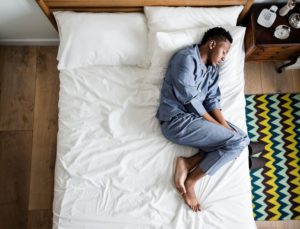Common Sleeping Positions for Couples
At some point in your life, you may share a bed with a partner. Sleeping next to them during the early stages of the relationship may feel comfortable. Eventually, you or your partner might start to spend more time wanting space in bed than cuddled up all night. Some people worry this shift indicates something is wrong.
Sleep positions are often chosen based on what feels comfortable in that moment of sleep. That said, there is some research suggesting that a couple’s sleeping positions and patterns may give some insight into the health of the relationship.
What Do Couples’ Sleep Positions Mean?
The meaning of couples’ sleep positions has not been extensively studied. Experts have hypotheses about what different sleep positions might indicate, but these meanings would need further study to be verified as true.
Spooning
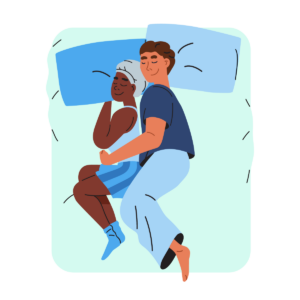

Spooning, in which both partners sleep on their sides, with one facing the back of the other partner, is a classic sleeping position for romantic partners. In a 2016 study, a majority of couples reported falling asleep in a spooning position at night.
How closely you and your partner spoon could be more telling than the position itself. Researchers have found that the farther apart a couple sleeps, the less close of a relationship they have. If you and your partner spoon tightly, this may suggest relationship closeness.
During the warmer months, spooning may be too uncomfortable for some. If you want an intimate sleeping position that does not cause you to overheat, you could try sleeping apart but facing each other. In this position, you can lightly touch each other’s hands instead of embracing.
Is Your Troubled Sleep a Health Risk?
A variety of issues can cause problems sleeping. Answer three questions to understand if it’s a concern you should worry about.
Stomach Sleeping
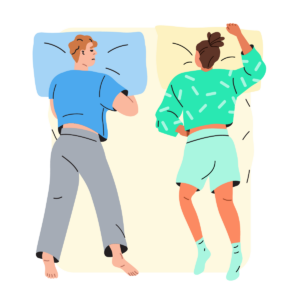

This position refers to both partners sleeping on their stomachs, typically without embracing. This sleeping position may be indicative of anxiety or lack of intimacy within the relationship. If you and your partner regularly sleep on your stomachs and are experiencing tension during waking hours, it can be helpful to have an open and candid discussion about the health of your relationship.
However, these signifiers may be inaccurate if this is a natural sleeping position for one or both partners. While stomach sleeping may help reduce snoring, habitual sleeping in this position could add strain to the lower back and neck.
Back-to-Back
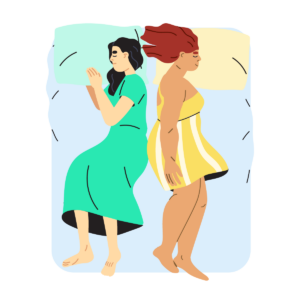
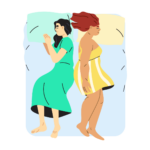
When sleeping back-to-back, both members of a couple lie on their side, but facing opposite directions. The name of this sleeping position depends on if bodies are touching or not. When they are touching, this couples’ sleep position is called the cherish position. When bodies are not touching, this is called the liberty position.
If one partner is sleeping in the fetal position, it may indicate they are feeling anxious or sensitive. If this is the case, it may help to set aside 5 minutes before bed to connect with each other and address any anxieties before going to sleep.
Back-to-back sleeping could also signify comfort and security in your relationship, and that you do not need constant touch to feel grounded. Back-to-back sleepers may have been in their relationship longer and prioritized sleeping comfort over cuddling.
Cliffhangers
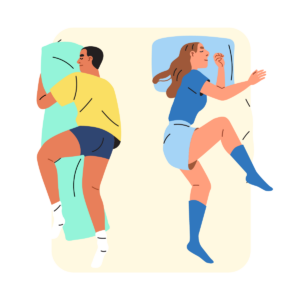
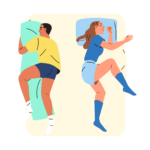
When you and your partner are sleeping on the opposite side of the bed, as far apart as you can get from one another, this may indicate a rupture in the relationship. Maybe you have recently had a fight or a disagreement. Taking time apart to decompress and calm down is considered an appropriate way to approach any rupture in a relationship.
Sleeping in the cliffhanger position also has a practical explanation. This position is most likely the best temperature option for couples who sleep hot or are sleeping in hot environments.
Intertwined


Sleeping intertwined is an intimate sleeping position that involves sleeping face-to-face in an embrace with legs intertwined. Also called the lovers’ knot, a reported 8% of couples sleep in this position. It could indicate that you are extremely close to your partner, or that you are in the early stage of your relationship and enjoying the bonding process.
This position may become uncomfortable or even result in numbness in the limbs if they are compressed. As a result, many couples prefer to only stay in this position for a few minutes before adjusting into another position.
Face-to-Face
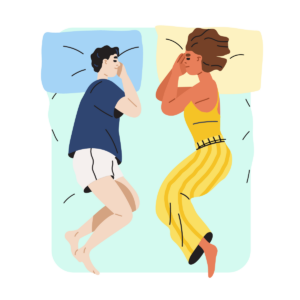
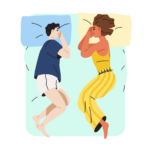
Similar to the intertwined position, partners sleeping face-to-face are in close proximity to one another, lying a few inches apart or with parts of their body touching. This position can signify both comfort and affection in the relationship, as well as mutual respect. It is estimated that approximately 4% of couples sleep in this position on a regular basis.
Face-to-face sleeping may not be ideal for those who prefer back or stomach sleeping or overheat easily during the night. This position could be best suited for the initial stages of falling asleep, and body temperatures can be regulated by sleeping with a slight distance between partners.
Head on Shoulder


Lying with your head on your partner’s shoulder, as they lie on their back with their arm around you, is not only a position of closeness, but also of protection. Only 4% of couples report sleeping in this position.
Maybe you gravitate toward this position because of stress, and your partner is subconsciously holding you close to help you feel safe and protected. Because this position often interferes with spinal alignment, it may result in neck pain or numbness in your arms. As a result, this position may not be a viable option for all-night sleep.
Starfish


The starfish position typically consists of one partner stretching out their limbs across the bed, leaving the other partner with limited sleep space. Even though one partner’s starfish pose can be indicative of their sense of intimacy and trust within the relationship, the sleep quality of the other partner may be hindered due to poor spinal alignment or lack of room to turn over.
If one partner is regularly dominating the sleep space, it can be helpful to talk through any unequal power dynamics or boundaries within the relationship. It may also be a sign that you and your partner are better suited for a larger mattress.
With Pets
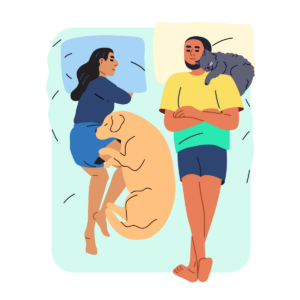
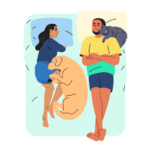
Around 56% of pet owners co-sleep with their pet, which can offer both humans and animals a sense of security and comfort. It has also been suggested that sleeping with pets has the potential to boost immunity and mental health.
However, sleeping with a pet may exacerbate allergies and increase exposure to certain pathogens. Partners may also feel cramped when sharing a bed with their pet, especially if the animal is larger in size or habitually sleeps with their body stretched out. Additionally, the animal’s early morning awakenings to be let out or fed may disrupt the sleep of both partners.
Benefits of Sleeping With a Partner
Sleeping with your partner can positively impact your mental health and overall well-being. Intimacy between couples goes beyond sex, and when you sleep with your partner, your heart rhythms synchronize . If you touch while sleeping, that can lead to further benefits. Physical touch can prompt the release of oxytocin, a hormone important in bonding, which is soothing and makes you feel less stressed .
Sleeping with your partner may also improve your sleep. There is evidence to suggest that co-sleeping with a partner increases REM sleep in addition to sleep quality and time spent asleep. Additionally, sleeping naked with a partner can potentially promote better self-esteem .

Challenges of Sleeping With a Partner
Many people choose to share a bed with their partner. While this may be an act of intimacy during the first few months of the relationship, sleeping with a partner can impact relationship health. Sleep problems and relationship issues tend to follow similar patterns in that during times of significant relationship stress , sleep satisfaction is also impacted.
Sleeping with a partner may mean that you are sleeping in a position that is new and different for you. Adults tend to shift positions throughout the night. Sleepers generally spend 54% of the time on their side, more than 37% of the night back sleeping, and 7% stomach sleeping. If sharing the bed restricts your movements and keeps you from moving between comfortable positions, stiffness and pain upon waking could potentially occur.
How to Get Better Sleep With Your Partner
due to a partner tossing or turning. Sleep disruptions can be caused by a variety of issues and an old mattress can be one of them. Investing in a mattress that is designed for couples may be the first step in reducing sleep disruptions when with your partner. New sheets and new pillows may also help you feel more comfortable and fall asleep faster. Trying other sleep aids, like earplugs or an eye mask, may help you and your partner get a good night’s sleep, together.
Dr. Wendy Troxel, a behavioral and social scientist, advocates for finding a sleeping agreement that works for both partners, even if it is not the social norm. While the current social assumption is that couples sleep together, sleeping apart may work better for some. Talk to your partner about what type of sleeping arrangement they feel most comfortable with, and leave space for uncommon or new ways of approaching sleep as a couple. You might find a solution that leaves both of you feeling more rested and rejuvenated than if you slept in the same bed.

Still have questions? Ask our community!
Join our Sleep Care Community — a trusted hub of sleep health professionals, product specialists, and people just like you. Whether you need expert sleep advice for your insomnia or you’re searching for the perfect mattress, we’ve got you covered. Get personalized guidance from the experts who know sleep best.
References
9 Sources
-
Junker, I., Bergel, J., Deresko, E., Freund, S., & Schredl, M. (2016). Sleep positions of couples at sleep onset: A questionnaire study. International Journal of Dream Research, 9(2), 137–141.
https://journals.ub.uni-heidelberg.de/index.php/IJoDR/article/view/32590 -
Krahn, L. E., Tovar, M. D., & Miller, B. (2015). Are pets in the bedroom a problem? Mayo Clinic Proceedings, 90(12), 1663–1665.
https://pubmed.ncbi.nlm.nih.gov/26478564/ -
Yoon, H., Choi, S. H., Kim, S. K., Kwon, H. B., Oh, S. M., Choi, J. W., Lee, Y. J., Jeong, D. U., & Park, K. S. (2019). Human heart rhythms synchronize while co-sleeping. Frontiers in Physiology, 10, 190.
https://pubmed.ncbi.nlm.nih.gov/30914965/ -
Uvnäs-Moberg, K., Handlin, L., & Petersson, M. (2015). Self-soothing behaviors with particular reference to oxytocin release induced by non-noxious sensory stimulation. Frontiers in Psychology, 5, 1529.
https://pubmed.ncbi.nlm.nih.gov/25628581/ -
Drews, H. J., Wallot, S., Brysch, P., Berger-Johannsen, H., Weinhold, S. L., Mitkidis, P., Baier, P. C., Lechinger, J., Roepstorff, A., & Göder, R. (2020). Bed-sharing in couples Is associated with increased and stabilized REM sleep and sleep-stage synchronization. Frontiers in Psychiatry, 11, 583.
https://pubmed.ncbi.nlm.nih.gov/32670111/ -
Drews, H. J., Wallot, S., Weinhold, S. L., Mitkidis, P., Baier, P. C., Roepstorff, A., & Göder, R. (2017). “Are We in Sync with Each Other?” Exploring the effects of cosleeping on heterosexual couples’ sleep using simultaneous polysomnography: A pilot study. Sleep Disorders, 2017, 8140672.
https://pubmed.ncbi.nlm.nih.gov/28465841/ -
West, K. (2020). I feel better naked: Communal naked activity increases body appreciation by reducing social physique anxiety. Journal of Sex Research, 5, 1–9.
https://pubmed.ncbi.nlm.nih.gov/32500740/ -
Richter, K., Adam, S., Geiss, L., Peter, L., & Niklewski, G. (2016). Two in a bed: The influence of couple sleeping and chronotypes on relationship and sleep. An overview. Chronobiology International, 33(10), 1464–1472.
https://pubmed.ncbi.nlm.nih.gov/27624285/ -
Skarpsno, E. S., Mork, P. J., Nilsen, T. I. L., & Holtermann, A. (2017). Sleep positions and nocturnal body movements based on free-living accelerometer recordings: Association with demographics, lifestyle, and insomnia symptoms. Nature and Science of Sleep, 9, 267–275.
https://pubmed.ncbi.nlm.nih.gov/29138608/













